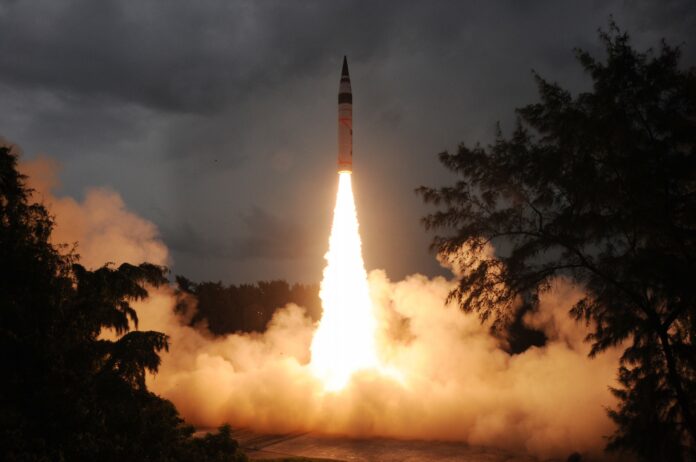India has successfully tested a new nuclear warhead delivery system with its intercontinental ballistic missile (ICBM) Agni-5, which will enhance its China deterrent, experts say.
The maiden flight of the Agni-5 missile, incorporating advanced multiple independently targetable re-entry vehicle (MIRV) technology, was launched on Monday from Dr APJ Abdul Kalam Island. The test saw the deployment of three MIRVs over a distance of over 2,000 miles, despite the missile’s range extending up to 3,000 miles.
India’s Defence Research & Development Organisation (DRDO) is the lead government organization behind developing the Agni series of ballistic missiles.
“Proud of our DRDO scientists for Mission Divyastra (“divine weapon” in Hindi), the first flight test of indigenously developed Agni-5 missile with Multiple Independently Targetable Re-entry Vehicle (MIRV) technology,” Prime Minister Narendra Modi said on X, formerly Twitter, on Monday.
The Agni-5 missile demonstrated its precision by ensuring the re-entry vehicles reached their designated targets with remarkable accuracy, Indian newspaper The Hindustan Times reported on Monday.
Pallava Bagla/Getty Images News/iStock
According to the Washington think tank Center for Strategic and International Studies, the Agni-5 ICBM has a range between 3,100-4,900 miles. The Agni-5 missile can cover most of the Chinese mainland, India’s primary target for this particular ICBM program.
Dr. V. K. Saraswat, who played a crucial role in developing the Agni-5 missile as a former director general of DRDO, lauded the test as a “huge force multiplier,” Indian news channel NDTV reported on Monday.
He explained that each “baby missile within the mother missile” is equipped with its own guidance and control system, enabling it to launch from approximately 200-250 miles above the main target site and hit independent targets, NDTV reported.
The integration of MIRV technology into the Agni-5 missile transforms the traditional missile system into a more versatile and potent weapon. By modifying the nose cone of the three-stage Agni-5 missile, it can now accommodate a variety of payloads, including micro-nukes, mini-nukes, and even large thermo-nuclear weapons, NDTV reported. Each MIRV functions as a precision-targeted tactical weapon.
This propels India into an exclusive circle of global powers with this capability, including the United States, the United Kingdom, France, Russia, and China.
Experts believe the Agni-5’s MIRV capability will significantly enhance India’s strategic and tactical nuclear deterrence and second-strike capabilities against China, particularly relevant given India’s “no-first-use” nuclear policy.
“Agni-5 is primarily aimed at deterrence towards China. This is evident from its range,” Shounak Set, a visiting lecturer at King’s College London, told Newsweek. “Pakistan had demonstrated MIRV capability last year. But it’s interesting that the Indian establishment prioritized MIRV for Agni-5, rather than shorter range missiles which are aimed at Pakistan.”
India and Pakistan have long had a hostile relationship following the partition of British India in 1947.
Rakesh Sharma, a retired Indian Army general who is now a distinguished fellow at the Vivekananda International Foundation think tank in New Delhi, also told Newsweek that the test sends a signal to China.
“China has attempted to geopolitically pressurize in manifold ways by creating a technological asymmetry. Indigenous development of MIRVed ICBM intimates to the region and world at large that India has the technological prowess. India also is a capable nation against an expansionist China,” Sharma said.
“It is essential to note that MIRV technology greatly increased the survivability of the missiles and challenges the missile defense system of the other side. It would stabilize India’s nuclear deterrent by enhancing massive retaliation of nuclear strike capability.”
Beijing possesses a range of nuclear-capable missiles that can target all regions of India. China and India have experienced a heightened phase over their military tensions at the disputed Line of Actual Control (LAC).
Since June 2020, the Chinese and Indian military have been tied up in an ongoing military stand-off, which has seen the deployment of 50,000 soldiers each on either side of the border.
Newsweek contacted China’s Embassy in New Delhi for comment.
Some experts argue further tests may be required to fully demonstrate India’s MIRV capability.
“While Agni-5 has had a number of flight tests, we likely will need to see many more for Agni-5 tests with MIRVs before the capability is ready for fielding,” Christopher Clary, associate professor of political science at the University at Albany, wrote on X on Monday.
Uncommon Knowledge
Newsweek is committed to challenging conventional wisdom and finding connections in the search for common ground.
Newsweek is committed to challenging conventional wisdom and finding connections in the search for common ground.


